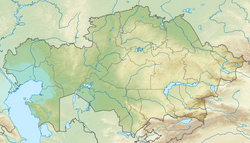Park of 28 Panfilov Guardsmen, Almaty
| Park of 28 Panfilov Guardsmen | |
|---|---|
| Paniflov Park | |

Entrance to the Park, with the WWII Monument.
|
|
| Type | Urban park |
| Location |
|
| Coordinates | 43°15′32.7″N 76°57′10.7″E / 43.259083°N 76.952972°ECoordinates: 43°15′32.7″N 76°57′10.7″E / 43.259083°N 76.952972°E |
| Area | 44 acres (18 ha) |
| Created | 1870's |
The Park of 28 Panfilov Guardsmen is a major park in Almaty, Kazakhstan. The park is located in east-central Almaty in the area surrounding Zenkov Cathedral. It is dedicated to and named after the Panfilov Heros, 28 soldiers of an Almaty infantry unit who died fighting Nazi German invaders outside of Moscow in World War II. The group takes its name from Ivan Panfilov, the General commanding the 316th division which, in spite of heavy casualties, believed at that time managed to significantly delay the Germans' advance on the capital, buying time for the defenders of the city. An eternal flame commemorating the fallen of the Russian Civil War and the Great Patriotic War burns in front of the giant black monument of soldiers from all 15 Soviet republics.
The Park was founded in the 1870s on the place of a cossack village cemetery, which was originally named Starokladbischensky Park (Old Cemetery Park). The cemetery was destroyed in 1921. The only preserved graves that avoided destruction were Kolpakovsky family was daughter Leonilla Kolpakovsky who was buried in 1860 and grandson of Vladimir Basilewski who was buried in 1882; which the gravestone was restored in 2011. Mass grave memory of victims of the 1887 earthquake are currently lost. Starokladbischensky park was later connected to the Catholic which it was called Urban Garden. The garden was removed which Andrey Pavlovich Zenkov participated in role of changing the park. The name of park changed on a regular basis, in 1899 during 100th anniversaty birth of famous Russian poet, Alexander Pushkin. The park changed its name to Pushkin Garden. Between 1904-1907, there was a period of construction on one of Almaty’s few surviving Tsarist-era buildings. In 1913, the park held agricultural and industrial exhibition for the 300th anniversary of the Romanov dynasty. Architectural and construction part was organized by military engineer, Andrey Pavlovich Zenkov. On the eastern part of the territory, new buildings were built in different architectural styles, 28 state-owned and 15 private pavilions. The main avenue of the park along the avenue Kolpakovsky was with decorated yurts, which housed all the diversity of the Kazakh national art, everyday life and crafts. Nearby the Ascension Cathedral, the city council, and the cinema which then was nicknamed "of the twentieth century" were equipped with the first electricity that affected the image of the "Garden City". The park changed its name to the "Park of the Fallen Heroes" in 1919 due to the burial of A. Berezovsky and K. Ovcharov and other heroes who participated in the Red Army during the Russian Civil War which then changed its name to "Local Park named after Lenin" with the prohibition of urban graves. During the years before 1927, the park was called variously called "Gubkompomarma Garden" or "Public Park of the 1st May". In 1927, during the conversion of Alma-Ata, as the new capital of Soviet Kazakhstan, the park was named "Federation of Soviet Republics".
...
Wikipedia


